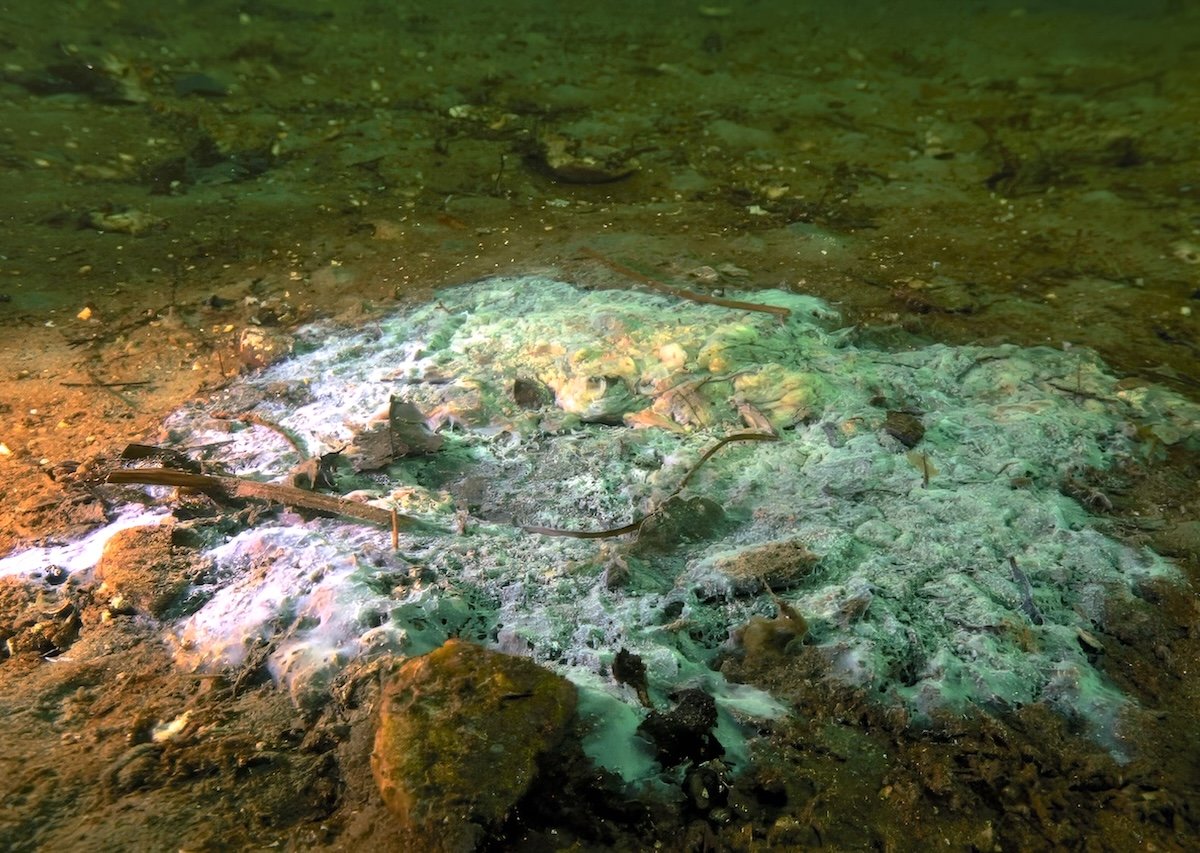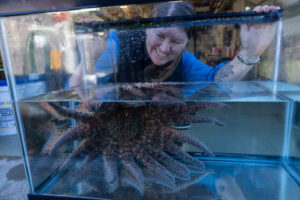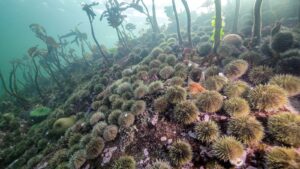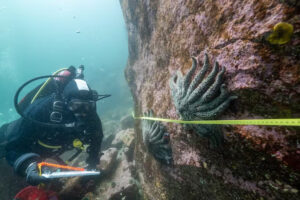
By JOHN RYAN/KUOW News
Researchers in Washington and British Columbia say they have solved a deadly mystery that has stumped scientists for more than a decade.
They have identified the pathogen behind one of the world’s biggest disease outbreaks: a wasting disease that has turned billions of sea stars into goo – from Alaska to California.
A mass dieoff of ocean-shaking proportions began among sea stars along North America’s West Coast in 2013. Of 20 species affected, the pizza-sized sunflower star was hardest hit. More than 5 billion sunflower stars, or 90% of their global population, wasted away.
With key predators of sea urchins largely wiped out, the spiny little grazers proliferated and chewed their way through kelp forests, leading to widespread losses of that productive ocean habitat.
For 12 years, the cause of the wasting disease was either unknown or, mistakenly, thought to be a virus. Instead, the new study says, it is a strain of bacteria known as Vibrio pectenicida. Other Vibrio bacteria sicken corals and shellfish. One species, Vibrio cholera, causes cholera in humans.

“It is not surprising that it is a Vibrio,” said biologist Alyssa-Lois Gehman of British Columbia’s Hakai Institute. “It was surprising because it took us so long to find out that it was a Vibrio.”
Gehman and her coauthors are not the first scientists to claim to have found the culprit behind the worst underwater wildlife pandemic on record.
In 2014, as the wasting disease was raging through West Coast waters, researchers named a densovirus as the deadly pathogen, only to have their findings proved wrong.
“There are a bunch of bacteria and viruses that are associated with sunflower stars that have nothing to do with disease,” Gehman said.
Gehman’s research team not only found much more Vibrio pectenicida in sick stars than in healthy ones. They were able to isolate the Vibrio, grow it in the lab, and give the wasting disease to healthy sunflower stars by injecting them with the Vibrio, steps the earlier researchers had not achieved.
“This is a much more convincing article than the previous one,” said Rebecca Vega Thurber, a marine microbiologist at the University of California, Santa Barbara, who was not involved in either study. “In 2013, we had the technology to be able to discover what this pathogen is. [Scientists] just looked in the wrong place.”
“It’s very exciting to see that they’ve been able to push through these challenges and actually identify a causative agent,” said University of North Carolina, Wilmington, microbiologist Blake Ushijima, who was not involved in the research. He called the study thorough and cautious.
“You don’t really see a lot of studies where they identify a pathogen causing disease in non-human things,” Ushijima said.
Melanie Prentice of Hakai Institute and Grace Crandall of the University of Washington work with sunflower stars at Marrowstone Marine Field Station near Port Townsend, Washington.
Gehman, who grew up in Seattle, recalled a time – not long ago – when sunflower stars were a common sight for tidepool explorers.
“I can remember from my childhood, you could go to Lincoln Park, and you could see at a low tide, several sunflower stars,” Gehman said. “If you go now, you’d be very lucky if you found one. And that’s sort of true everywhere.”
In 2020, the International Union for Conservation of Nature declared the sunflower star critically endangered, the first sea star to gain that status. In 2023, the U.S. government proposed listing the sunflower star as a threatened species, a process that is still under way.
The current study grew out of four summers of experiments at the U.S. Geological Survey’s Marrowstone Marine Field Station, a beachfront facility on Marrowstone Island, near Port Townsend, Washington. Avoiding microbial contamination was a top priority.
“There’s a lot of ethanol and bleach and betadine,” Gehman said. “There’s a lot of cleaning that’s happening all the time.”
Researchers stepped in foot baths when entering and leaving the facility. Each sunflower star, after enduring a two-week quarantine, lived in its own tank with its own supply of sand-filtered, ultraviolet-treated seawater. Researchers avoided touching the stars, even with gloves on.

In January 2024, after analyzing the previous summer’s data, the researchers found large amounts of Vibrio pectenicida in sick sunflower stars and hardly any in healthy stars.
The team wanted to launch more experiments for confirmation, but wasting strikes mostly in warmer waters, making sick stars especially hard to find in January.
“We sort of sent out emails to everybody we knew and asked them to find a wasting sea star if they could,” Gehman said.
Biologist Jason Hodin, whose team at the University of Washington’s Friday Harbor Labs on San Juan Island has raised 400 sunflower stars in tanks, replied. One of his tanks was suffering an outbreak.
“This one came when almost my entire team was at a conference in Seattle,” Hodin said.
Gehman said she and coauthor Melanie Prentice immediately jumped in a car and drove to San Juan Island. “We arrived at like 8 p.m. and were sampling at 10 p.m. in these outside tanks in the dark with headlamps,” she said.
While the process of discovery can have exciting moments, studying a disease that gruesomely kills members of a species on the verge of extinction can be emotionally draining. That’s especially true for the research assistants who did most of the hands-on animal care and feeding, Hodin said.
“They spend so much time caring for all the stars and knowing their names and getting to know them over years,” Hodin said. “It’s a traumatic experience whenever our stars get sick.”
“What you’ll see is one arm will detach from their body and kind of walk away, which is horrifying,” Gehman said. The rest of the body then melts away, usually within a few days of the disease onset.
Sunflower stars have become so rare that taking any from the wild is both difficult and potentially harmful to the species.
“We ran at sort of the bare minimum necessary to get robust and strong evidence,” Gehman said. “My sort of pledge to myself, as I did this work, was that any animal that died, we would learn something from that.”
Gehman said her team would regularly take moments to acknowledge how intentionally sickening animals in their care affected them.
“We would talk about how sad the work feels, because it is incredibly sad,” she said. “There were really hard moments in the lab, but the fact that we’ve found the cause means that we can actually try to recover the species.”

Gehman said they have already successfully infected another keystone species of sea star, the ochre star, with Vibrio and have started testing 15 other species. Researchers are also starting to develop probiotics to help healthy stars ward off the disease.
“There are a bunch of things we can do now that we know what causes this disease that might actually change the tide and make it so these animals can survive,” Gehman said.
Vega Thurber, who was not involved in the study, was similarly optimistic about next steps.
“Hopefully, with this new information, we can now start a monitoring program to confirm where the pathogen is present and to begin the process of restoring sunflower star populations so that kelp forests can start to recover from the sea urchin outbreaks,” Vega Thurber said.
Where the research can continue is unclear: The future of labs like Marrowstone is in doubt.
The U.S. Geological Survey’s Marrowstone Marine Field Station sits on the shore of Admiralty Inlet on Marrowstone Island, near Port Townsend, Washington. The Trump Administration has proposed cutting the U.S. Geological Survey budget 38% in 2026 and eliminating its biological research arm, which environmental advocates call “the backbone of environmental and ecological monitoring in the United States.”
The Trump proposal would include shutting down the Marrowstone lab and four other fisheries research centers in Oregon and Washington.





















The ecosystem we live on, Earth, is very cyclical. Just a mere blink in the past in geologic terms where we live and most of North America was covered in ice. Some species adapt and live on and some species don’t and die. New species emerge in response to the changing climate. It’s the way the world works.
Yeah, we know. We all took high school bio. But knowing that things like this happen does not negate the newsworthiness when living through them. Studying things like disease, species collapse and environment degradation should continue to be publicly funded. Most people would much rather live in a society that prioritizes intellectual curiosity over arming and funding genocide. I mean, why did DOGE de-fund science and ignore the military? Trump and his followers are juvenile, un-American traitors. Long live the pizza-sized starfish. Long live the unquenchable thirst for knowledge.